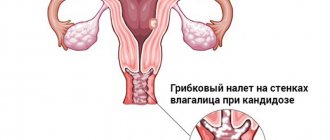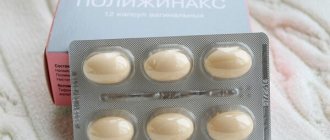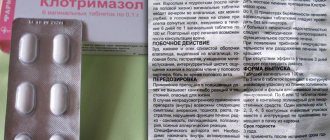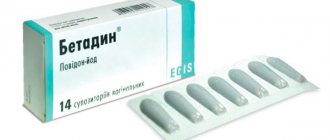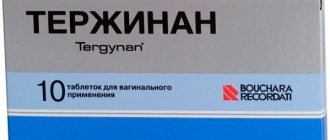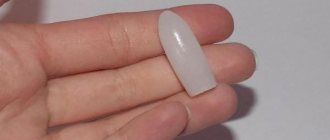08/22/2018 Category: Treatment during breastfeeding Author: Natalya Grebennikova
Candidiasis (thrush) is an unpleasant and, unfortunately, common ailment during lactation. However, many antifungal agents are incompatible with breastfeeding. For example, tablets quickly help with thrush, but they should not be used during lactation. Suppositories are the safest, so you should familiarize yourself with the features of their use and follow the instructions of your gynecologist.
- Gentle drugs that can be combined with lactation
HexiconVideo: instructions for use of Hexicon
- Video: methods of using Clotrimazole
- Video: use of Pimafucin
- Betadine
Video: instructions for use of Nystatin
- Klion-D
Video: using Polygynax
- Video: instructions for use of Terzhinan
- Table: popular suppositories for thrush, their advantages and disadvantages
- Video: how to insert suppositories for thrush
Symptoms of thrush
Thrush is candidiasis, or an infection caused by Candida fungi. Or rather, their rapid reproduction, since such fungi are present in the vagina of every woman and do not appear if the body is healthy and there are no favorable factors for the development of the disease. Almost always, thrush during breastfeeding is accompanied by the following symptoms:
- Vaginal discharge, unpleasant burning and itching in the genital area appear. The discharge is usually white, has a sour odor and is somewhat reminiscent of cottage cheese in consistency.
- After sexual intercourse, bathing and sleep, the discharge increases.
- In some cases, swelling of the labia majora appears, as well as redness and irritation in the groin area.
- In advanced cases, a woman feels pain during urination.
Most often, the disease affects mucous surfaces, but skin around the breast and nipples are also often affected. Often similar manifestations and symptoms appear during breastfeeding.
Terzhinan
This drug is a vaginal tablet, and they are considered relatively safe for use during this period.
The drug contains several active components: ternidazole, neomycin, prednisone, nystatin. This composition determines the therapeutic effect not only against fungi of the genus Candida, but also against some other viruses, bacteria and sexually transmitted infections.
However, this composition of the drug does not have a destructive effect on the vaginal microflora and maintains a constant level of acidity. All individual medicinal components are not absorbed into the blood of a nursing mother or it is minimal.
In the last stages of pregnancy, almost before childbirth, such vaginal tablets are often prescribed to prevent various diseases, including thrush.
Joint treatment with a partner minimizes the risk of relapse of the disease.
Therapy with Terzhinan allows continuous treatment even during menstruation. Naturally, during such a period the absorption of the components of the product will be significantly lower.
Terzhinan has a minimal set of side effects. These only include possible allergic reactions and a slight burning sensation after administration of the tablet. Do not be afraid of pinkish discharge during treatment - this is considered normal.
Before inserting the tablet into the vagina, you need to hold it in water for about half a minute. If treatment is not carried out before bedtime, then after administering the tablet you need to take a horizontal position for 15 minutes.
The standard treatment regimen involves a ten-day period. For complicated forms of candidiasis, you can increase it to 20 days. Two weeks after therapy, it is recommended to take a control smear to determine the effectiveness of treatment.
Causes
Typically, the main factor in the occurrence of candidiasis is a previously incompletely cured disease. Other causes of the disease are:
- Too early onset of sexual activity (before 16 years of age).
- Complicated childbirth, caesarean section, psychological difficulties of the mother during childbirth.
- Hormonal changes in a woman's body.
- Use of aggressive hygiene products when bathing.
- Taking strong medications or antibiotics.
- A sedentary lifestyle, which provokes stagnation of blood in a woman’s pelvis and causes the development of thrush.
- The disease can worsen due to intestinal diseases and chronic ailments of the reproductive system.
We recommend reading: When can you spin a hula hoop after a caesarean section, how long after can you spin a hula hoop?
The body’s protective abilities drop seriously after childbirth, since labor is a huge stress, and it doesn’t matter whether it’s the first birth or the fifth. The immune system will recover much later, 5-6 months after the birth of the child. In addition, immediately after the birth of the baby, the hormonal background changes sharply, as a result of which the vaginal microflora begins to multiply rapidly, provoking the development of the disease.
Why do pregnant women get sick?
The period of bearing a child is accompanied by enormous stress on the female body. Global changes are taking place inside it - changes in hormonal levels, active consumption of nutrients and vitamins, changes in the position of internal organs. The body reacts to such metamorphoses not only with changes in a woman’s mood and taste preferences, but also with a decrease in immunity.
During pregnancy, women are more vulnerable to various infections, including fungi
Physiological immunodeficiency is a temporary decrease in the resistance of the female body associated with pregnancy. It is caused by hormones. Namely, a decrease in estrogen levels and an increase in progesterone. This substance “puts to sleep” the vigilance of the immune system to ensure reliable attachment of the embryo in the uterus. Without such a mechanism, the baby’s body would be attacked by immune cells, and the pregnancy would end in miscarriage.
Thrush is an imbalance in the vaginal microflora. It reduces the number of lactobacilli and increases the concentration of opportunistic (potentially dangerous) microbes, including fungi. Candida multiplies quickly, creating colonies on the surface of the mucosa. In advanced cases, they change - they become thread-like, capable of penetrating deep into the membranes, causing chronic thrush.
What to do if you have thrush?!
Read more >> |
Shifts in the composition of the microflora occur not only due to endocrine changes. Thrush during pregnancy can be triggered by medications, poor hygiene, abuse of sweets, the use of aggressive intimate gels, colds and viral diseases.
The effect of thrush on lactation
In no case should you stop breastfeeding if thrush is detected, since this disease can be treated simply and does not require intensive therapy. The only caveat is that at this time the amount of milk produced by the body may decrease, which is greatly facilitated by chest pain. In addition, thrush affects health and nutrition; the development of the problem only aggravates the situation: the child refuses to suckle, further reducing milk production.
If you do not get rid of the fungus during breastfeeding, the baby may refuse to breastfeed altogether, so it is necessary to start treatment as early as possible.
Fortunately, treatment of thrush in women who are breastfeeding is successful in most cases, and almost all mothers manage to completely cure the disease without stopping lactation.
Pimafucin
The use of this remedy for thrush is the optimal solution for lactation. Pimafucin is considered the No. 1 drug in the treatment of candidiasis during the entire period of pregnancy (including the 1st trimester) and breastfeeding.
The main active component of this drug is the antibiotic natamycin, which has a wide spectrum of action. Natamycin does not have a destructive effect on the vaginal microflora and cannot harm milk production processes. This component is distinguished by the fact that it is practically not absorbed into the blood.
It is enough to administer 1 suppository every day for 3-6 days to achieve complete relief from the symptoms of thrush.
The uniqueness of the drug is that it is also available in the form of a cream. This is especially useful if signs of thrush appear on the nipples. Pimafucin cream should be used to treat the nipples and the area around them after the feeding process. Before breastfeeding your baby again, it will be enough to thoroughly wipe the mammary glands to remove any remaining cream.
Benefits of using candles
Suppositories for thrush during breastfeeding are preferred by most women because they are effective, safe and do not in any way affect the composition and taste of milk. Of course, during drug therapy you will have to change your lifestyle a little, pay more time and attention to intimate hygiene and follow other simple rules. When using vaginal suppositories, you can also use herbal infusions - it is recommended to wash yourself with them in the evening before bed, even before using the suppository.
Prevention of relapses during lactation
As you know, any disease is easier to prevent than to treat later. This is especially true for nursing mothers - compliance with preventive measures will allow her to avoid unwanted use of medications during lactation. Such events include:
- Be sure to carry out daily washing using specific care products;
- Include mandatory breast care in personal hygiene procedures;
- Change pads regularly, and do not use hygiene products with fragrances. Also, avoid using scented toilet paper;
- Under no circumstances use other people’s shower accessories – towels, washcloths, etc.;
- Make sure your diet is balanced and contains the maximum amount of vitamins and nutrients;
- Avoid public places where you can easily get candidiasis (saunas, steam baths, swimming pools);
- Use underwear only from natural materials and change it regularly. It is advisable to iron it before wearing it;
- Avoid wearing underwear that is too tight (such as thongs);
- Strengthen the immune system using probiotics or vitamin complexes;
- Following a diet that avoids sweet foods and foods will not allow Candida to develop.
Tags: feeding, breastfeeding, which, possible, thrush, suppository About the author: Admin4ik
« Previous entry
Suppository selection
There are proven medications for breastfeeding that will help get rid of thrush. However, only a doctor should prescribe them, since all drugs have their own characteristics of action, contraindications and side effects. The most effective suppositories for this disease are presented below:
- Pimafucin. This is perhaps the best remedy for thrush and is very popular among women. The main active substance is natamycin. Suppositories must be inserted into the vagina before bed every day. The course of therapy lasts 6-9 days.
- Hexicon. These are completely safe suppositories for breastfeeding. The drug contains chlorhexidine, which is the main active ingredient. However, this remedy is recommended to be used as a preventive measure for the disease - if thrush already exists, you should consult a doctor for additional advice.
- Clotrimazole. As practice shows, Pimafucin, Zalain and Clotrimazole are the most popular and safe among all suppositories for the treatment of thrush during breastfeeding. The treatment time lasts 7-10 days, suppositories must be inserted into the vagina once a day before going to bed.
- Terzhinan. The drug combines antifungal, anti-inflammatory and antibiotic agents, and therefore should be used by a woman only with the permission of a doctor. Clotrimazole and Terzhinan are included in the group of conditionally acceptable drugs during feeding. The course of treatment is 7-10 days. Before using, it is better to immerse the candles in water for 10 seconds.
We recommend reading: Treatment of cough during breastfeeding: how to treat, effective remedies
Today there are a lot of vaginal suppositories that are also allowed during breastfeeding. Thus, analogues of the popular Pimaftsin are Primafungin, Ecofucin and others. Zalain, Clotrimazole are not recommended for use during feeding - only if the degree of development of candidiasis is high. Hexicon, Pimafucin, according to most gynecologists, are the most harmless drugs for feeding. There are also topical suppositories, which your doctor will tell you more about during your consultation.
Medicines improve the vaginal microflora, kill fungal infections and restore mucous tissue. Temporary itching and discomfort during treatment is normal - this must be tolerated.
Candidiasis suppositories for nursing mothers
A woman's body is very vulnerable and weakened during breastfeeding. Heavy workload, stress and lack of vitamins sometimes lead to unpleasant diseases. Unfortunately, thrush during lactation is a common occurrence.
Thrush is a candida fungus that affects the genitals and sometimes the milk ducts and nipples. The causes of the appearance and development of infection can be a sharp change in hormonal levels and a decrease in immunity, non-compliance with hygiene standards or taking medications, especially antibiotics and hormonal drugs. In addition, cracks and abrasions on the nipples can lead to infection.
The spread of thrush to the nipples is very dangerous for a baby, as the baby himself can become infected. Therefore, it is important to recognize the fungus in time and begin treatment.
- burning and itching in the vaginal area;
- cheesy white discharge with a sour odor;
- pain when urinating;
- nipples become swollen and itchy, turning pink or reddish;
- formation of bubbles on the nipples;
- acute pain in the chest during feeding, which intensifies after the end of feeding;
- sometimes the volume of milk is reduced.
Only a doctor should prescribe any medications. Since the composition of many drugs penetrates into the blood and breast milk, which causes a negative reaction in the baby. These are allergies, poisoning, digestive disorders and even developmental delays. In addition, some products change the composition and reduce milk production.
Therefore, it is necessary to carefully choose medications during lactation. The most effective remedy for thrush are suppositories and ointments, especially Pimafucin, Clotrimazole and Terzhinan. It is necessary to use products for external use, since tablets taken orally can be harmful to the health of the baby and mother.
Treatment of thrush during lactation at the initial stage and with minor damage can be carried out using ointments. The ointment is also great for treating nipples. However, wash your nipples thoroughly before feeding!
If the infection is established, suppositories must be used. Let's look at which suppositories for thrush during lactation are best to use and which ones should not be used.
Pimafucin is the optimal remedy for a nursing mother, since the drug is not contraindicated during breastfeeding. The composition of the drug does not destroy microflora and does not affect the quantity and quality of milk. Eliminates harmful fungus in a short time and restores immunity;
It is not recommended to take Terzhinan during lactation, as it suppresses normal microflora and requires a long course of treatment of about two weeks. They are produced in the form of tablets, which are moistened in water and placed in the vagina until completely dissolved.
Clotrimazole is also not suitable to treat thrush during breastfeeding. The only advantage of the drug is its inexpensive cost. Please note that Clotrimazole has a large number of serious side effects. Such effects include the appearance of cystitis and abdominal pain, itching and burning, and headaches.
Based on materials from vskormi.ru
Candidiasis, commonly referred to as thrush, belongs to the category of fungal diseases and is characterized by the appearance of severe itching, burning, and atypical discharge. One of the factors provoking its development is lactation. This is due to the fact that to produce breast milk, a woman’s body expends a huge amount of useful substances and energy, which leads to a weakening of immune forces. It is imperative to treat candidiasis, as there is a risk of infection in the child. The best option for conservative therapy is the use of suppositories for thrush during lactation. This method is practically safe and does not have a negative effect on the composition of breast milk.
A typical distinctive feature of the behavior of a nursing mother is the limitation of the amount of necessary attention to her own health due to the presence of priorities such as the health of the newborn. Most women prefer to postpone treatment of existing diseases until better times.
And if in some cases this can still be justified, then against the background of candidiasis it is not recommended to ignore therapy, since there is a high risk of infecting the baby. In addition, the use of such a safe and effective product as suppositories does not have a negative effect on the organisms of the mother and child. Using suppositories for thrush while breastfeeding is not only safe, but also convenient. Their main advantages include:
- Convenient to use.
- Does not require the use of additional medications.
- Do not contain substances that have a negative effect on the composition of breast milk.
- They are highly effective.
When choosing the appropriate option for suppositories for thrush during lactation, it is recommended to choose the right medication and draw up the optimal treatment regimen. It should be remembered that the lack of therapy can lead to the spread of candidiasis and the appearance of fungal formations on the nipple halos, which is one of the causes of infection in the child.
Important! When breastfeeding, it is recommended to use only suppositories that are included in the list of products approved by the Ministry of Health for use during lactation.
When purchasing suppositories for thrush while breastfeeding, it is recommended to be guided by such selection criteria as the composition of the medication, the presence of restrictions and possible side effects, and specialist recommendations. Chronic thrush, as well as an advanced form of the disease, may require treatment through the use of potent drugs, the use of which involves stopping breastfeeding.
To eliminate typical symptoms, it is enough to use suppositories. When giving preference to medications presented in the form of suppositories, one should not forget about precautions. To prevent infection of the child and repeated self-infection, you should thoroughly wash your hands and treat them with antibacterial agents after each procedure for administering the medicine.
The main active component of Hexicon suppositories is chlorhexidine bigluconate, an effective antiseptic substance with virtually no contraindications. It is completely safe and can be used both during breastfeeding and during gestation.
Suppositories for candidiasis during breastfeeding act as follows: after administration, the suppository completely dissolves, enveloping the mucous tissues with an antiseptic film, which helps suppress pathogenic microflora and eliminate the characteristic symptoms of thrush. The active ingredients of the drug are practically not absorbed into the systemic bloodstream, which makes it completely safe, including during lactation.
When thinking about which suppositories for thrush can be used during lactation, you should first of all pay attention to the indicated medication. This is due to the fact that it is not only highly effective, but also does not disturb the natural microflora of the mucous tissues of the internal organs of the reproductive system and quickly eliminates discomfort.
The duration of the treatment course is determined by the attending physician and can vary from seven days to two weeks. To obtain effective treatment results, you must use one unit per day. According to reviews of patients who have undergone treatment with Hexicon, the first results and relief occur after the first procedure.
Important! To increase the effectiveness of the product, it is recommended to remain in a horizontal position for one hour after administering the suppository.
Among the most effective and potent drugs that can be used, including for the treatment of chronic and advanced candidiasis, is the drug Zalain. The composition of the drug is enriched with the active ingredient sertoconazole, a substance that inhibits pathogenic microflora by suppressing reproductive activity after a single use.
It is recommended to use these suppositories for thrush during breastfeeding in strict accordance with the doctor’s instructions, as they have some contraindications for use. To eliminate the symptoms of candidiasis and prevent the recurrence of the disease, it is enough to administer just one suppository. If necessary, the course can be repeated. However, you should not use more than two suppositories within thirty days.
The only disadvantage of the drug Zalain is the body’s natural reaction to the active components of the drug, which consists in the appearance of copious mucous secretions. This symptom is normal and disappears completely after a few days. It is not recommended to carry out any procedures aimed at reducing the amount of discharge. It is enough just to follow the rules of intimate hygiene.
Important! When using more than two units of medication within a month, there is a risk of developing reactions of allergic etiology and disruption of the natural microflora of mucous tissues.
During lactation, you can also use suppositories for thrush Pimafucin. The pharmacological properties of this drug are as follows: the active substance penetrates the membrane membrane of cells and completely destroys it, neutralizing hostile microflora. Nitamycin is used as the active component of suppositories, a substance that has a local effect and does not penetrate the systemic bloodstream.
Currently, the drug is one of the most effective, since the likelihood of resistance, that is, the resistance of pathogenic microorganisms to the active components of the drug, is close to zero. Suppositories for thrush during lactation are recommended to be used for three to six days. To prevent relapse, it is advisable to extend the course of treatment to eight days. It is recommended to carry out the procedure for administering a unit of medication once a day.
For the most part, suppositories for thrush, which can be used during lactation, are quite expensive. However, there are also budget options that are quite effective, quickly eliminate the main symptoms of candidiasis, do not have side effects and have a more than attractive price. These include, for example, the drug Clotrimazole.
Clotrimazole vaginal suppositories contain the main active ingredient imidazole, which has a local local effect, effectively inhibits pathogenic microorganisms and does not have a negative effect on the state of natural microflora. Medicinal substances do not enter the general bloodstream, which allows the use of the medication during the feeding period.
To eliminate fungus, it is recommended to use suppositories twice a day for seven days. After the procedure, you must remain in a horizontal position for an hour. According to reviews from representatives of official medicine, Clotrimazole is a drug that is safe for the health of the child and mother, for nursing mothers, however, before using suppositories, it is recommended to agree on a treatment regimen with a doctor.
So, above are recommendations regarding which suppositories for thrush are acceptable to use while breastfeeding. But you should know that types of drugs classified as gentle help suppress pathogenic microflora only in the early stages of the disease.
In case of chronic candidiasis, as well as in advanced cases, the use of potent medications is required, the use of which is a mandatory indication for cessation or temporary suspension of lactation. This requirement should be observed especially strictly if the child is a newborn; suppositories for thrush during breastfeeding can cause harm to the baby’s health. Drugs prohibited during lactation include:
- Livarol. A drug that promotes a fungicidal effect on pathogenic microflora. The active components of the drug penetrate the systemic bloodstream and, accordingly, breast milk, which prevents use during lactation.
- Ruvidon. Among the active components of the drug is povidone - iodine. Penetrating into breast milk through the systemic bloodstream, this substance can harm the baby by having a negative effect on the functioning of the thyroid gland.
- Polygynax. An effective product with a pronounced antibacterial and antimicrobial effect. Not recommended during breastfeeding due to the penetration of active components into breast milk.
As a rule, the total duration of the treatment course using the above remedies is from three to fourteen days. In this regard, there is no need to completely stop lactation. It is enough to take a break for the required period, and then resume breastfeeding.
Choosing the most suitable suppositories for thrush for a nursing mother is not the only requirement when identifying such an unpleasant disease as candidiasis. In order to prevent the child from becoming infected and a possible relapse of the disease, it is recommended to follow certain rules during the therapeutic course:
- The main requirement is compliance with the rules of intimate hygiene. It is advisable to wash the external genitalia at least three to five times during the day, using special means for this purpose.
- It is also necessary to wash the chest with warm water at least twice a day; this measure will minimize the likelihood of infection of the child.
- It is necessary to use special bra pads that will absorb excess liquid.
- After each trip to the toilet, you should wash your hands thoroughly.
- It is recommended to take a shower or bath at least twice a day.
Due to immature immunity and relatively weak body resources, a child receiving breast milk is at risk of contracting a fungal disease. That is why treatment of thrush should be carried out without fail immediately after the first signs of the disease appear.
But every nursing mother should know that self-medication through uncontrolled use of even the safest and most harmless drugs can harm both the health of the baby and the woman herself. To prevent possible negative consequences, you should always consult your doctor before using any medication.
Based on materials from venerbol.ru
During pregnancy and lactation, the female body experiences severe stress. Stress, deficiency of vitamins and nutrients cause a decrease in immunity, which creates a favorable environment for the development of candidiasis. The use of suppositories for thrush during breastfeeding should be done very carefully, since an incorrectly selected drug can have a negative impact on the development of the child.
When breastfeeding, only a doctor should prescribe suppositories for candidiasis, since a large number of medications contain substances that can end up in a woman’s blood and in her breast milk. Together with mother's milk, such components can enter the child's body and cause:
- allergic reactions;
- poisoning;
- digestive disorders;
- developmental delay.
Some medications also affect the lactation process, reducing its activity, as a result of which the baby does not receive the required amount of nutrition.
A breastfeeding baby may refuse to suckle due to the mother's use of suppositories that affect the characteristics of the milk, changing its taste and reducing its nutritional quality.
The use of suppositories for thrush while breastfeeding is allowed in case of an actively developing infection. If a woman notices primary signs of pathology, she can use folk recipes to eliminate it.
The best option for nursing mothers suffering from developed candidiasis is the use of suppositories that do not have a detrimental effect on the child’s body. But the best remedy during breastfeeding is considered to be one whose components are not absorbed into the blood and do not pass into milk.
In order not to harm her baby, a mother during lactation should use only those suppositories that are not contraindicated for nursing women to treat thrush.
There are several topical medications that are not absorbed into the bloodstream and breast milk, but maintain their effectiveness during the treatment of candidiasis at a high level. The safest option is the use of Pimafucin and Zalain for thrush.
The most effective drugs used to treat candidiasis in hepatitis B are suppositories Pimafucin, Zalain, Clotrimazole, Terzhinan . Despite the fact that many doctors prescribe these medications, some of them are not recommended for use during breastfeeding, as they are characterized by a large list of side effects. Such suppositories for thrush include Clotrimazole and Terzhinan.
During lactation, it is not recommended to use Clotrimazole suppositories due to the high risk of side effects:
- formation of cysts (protective membranes of parasites and bacteria);
- the appearance of pain in the abdominal area;
- the appearance of itching, burning;
- occurrence of headache.
If your doctor has prescribed this medication, you should use it according to the following rules:
- take only in a dosage that is safe for the child: 2 times a day, 1 suppository;
- after administration of the drug, you need to lie down for 1 hour;
- the course of treatment should not exceed 7 days.
Terzhinan is not recommended for breastfeeding due to its suppression of normal vaginal microflora and the need for long-term use (14 days).
Vaginal capsules are used daily, 1 piece. The listed drugs can be used to treat candidiasis during lactation only after consulting a doctor and establishing that the expected benefit received by the mother exceeds the likelihood of side effects in the baby.
Doctors may also prescribe other medications to treat thrush. Nystanin, Levorin, Natamycin are most often prescribed.
Nystanine is considered safe during lactation, but ineffective, which is why it is rarely prescribed for the treatment of candidiasis. Due to the negative impact on the child’s body, Levorin is prescribed extremely rarely during lactation when other drugs do not have the desired therapeutic effect on the female body. Many experts recommend stopping breastfeeding or reducing the dosage to safe levels during treatment with this drug.
One of the best options for treating thrush during lactation is the use of Pimafucin. The drug has no contraindications for its use during lactation, and its composition does not contribute to the destruction of normal vaginal microflora and does not affect the processes responsible for milk production. The administration of these suppositories for thrush during lactation should be carried out daily for 3-6 days. The daily dosage of the drug is 1 suppository.
An analogue of Pimafucin is Natamycin. This medicine is used in a similar way - 1 suppository is inserted into the vagina.
Another safe drug for candidiasis is Zalain. Refers to topical products that do not enter the bloodstream or breast milk. When using suppositories, discharge may appear, which should be washed out with a syringe. During this period, they need to use sanitary pads for daily use. This reaction of the body is normal and does not require special treatment.
To combat the disease, it is enough to administer 1 suppository. In advanced cases, a repeated single dose of the medication is allowed after 14 days.
Hexicon suppositories, which contain an antiseptic substance, also help to get rid of thrush without harm to health. The advantage of this drug is that it targets only pathogenic microorganisms without disturbing the normal microflora. The medication is completely safe for use by nursing mothers. The course of treatment is 7–10 days. One suppository is inserted into the vagina every day.
If a woman has repeatedly developed thrush during pregnancy, to prevent recurrence of this disease during lactation it is necessary to use folk recipes. They will also help cope with candidiasis, which is at an early stage of development.
Before using any self-prepared product, you should consult a doctor, as some components can reduce the activity of milk production and harm children's health.
Baking soda is safe for children. To prepare and use the medicinal solution you will need:
- Dissolve 2 dessert spoons of soda in 0.5 liters of boiled water.
- The resulting liquid must be wiped over the affected areas several times a day if candidiasis appears on the nipples. If the thrush is localized in the vagina, douching should be done with a soda solution. The procedure is performed every day before bed. The maximum course of treatment with soda is 7 days.
If the product dries the skin, causes burning or itching, it is better not to use it.
This product should be used for local treatment of affected areas.
- 2 dessert spoons of dried chamomile flowers are poured into 0.5 liters of boiled heated water.
- The liquid is left for half an hour and then filtered.
- The affected areas should be treated with the resulting infusion 2-3 times a day.
If the infusion is used for nipples, they should be washed thoroughly before feeding. To treat the vagina, you need to use a syringe.
The drug can be used as part of drug therapy for advanced thrush with pronounced symptoms. It must be used very carefully, as it can cause an allergic reaction.
- Add 2 drops of tea tree oil to a bath of warm water.
- The bath is taken for 15 minutes.
- The procedure should be completed with a shower.
This helps relieve pain, itching, burning caused by candidiasis.
Before feeding the baby, the breasts should be rinsed with clean boiled water.
If there are no contraindications for a child, a woman should drink an increased amount of green tea. It must be taken warm. In this case, the drink should be moderately brewed. Sugar should be excluded from its composition.
Green tea not only helps remove pathogenic yeast microflora from the body, but also reduces pain. Another advantage of this drink is that it stimulates lactation.
Before treating thrush while breastfeeding, you should consult a doctor, as some medications can cause an allergic reaction not only in the mother, but also in the baby. If the listed treatment methods do not suppress the pathology, doctors recommend stopping breastfeeding and fighting the disease using an integrated approach.
Based on materials from topginekolog.ru
Prohibited drugs
There are medications for thrush that are strictly prohibited for pregnant and nursing mothers, as they can seriously undermine the baby’s health. To prevent this from happening, during lactation you should be especially attentive to your health, and go to the doctor with all questions. Drugs that are strictly prohibited for use during hepatitis B are:
- Diflucan. It helps perfectly against thrush, but it should be used only after lactation is completely completed. Accepted once.
- Lomexin. If you need to get rid of thrush during breastfeeding, the drug is definitely not suitable: contraindications include pregnancy and lactation. The medicine is also taken only once.
- Nystatin. There is no clear prohibition on its use during breastfeeding, but it is recommended to refrain from taking it, since it is unknown what effect it will have on the baby. Additionally, this drug must be taken twice a day for 15 days, but the drug makes up for this by being cheap.
Drug therapy (treatment of thrush during breastfeeding) should be carried out only under the supervision of the attending gynecologist. Otherwise, the woman can cause irreparable harm to the health of the child.
How to get out of the situation
The best option for nursing mothers suffering from developed candidiasis is the use of suppositories that do not have a detrimental effect on the child’s body. But the best remedy during breastfeeding is considered to be one whose components are not absorbed into the blood and do not pass into milk.
In order not to harm her baby, a mother during lactation should use only those suppositories that are not contraindicated for nursing women to treat thrush.
There are several topical medications that are not absorbed into the bloodstream and breast milk, but maintain their effectiveness during the treatment of candidiasis at a high level. The safest option is the use of Pimafucin and Zalain for thrush.
Tips and tricks
There is a lot of advice on the Internet on how to treat thrush with pharmaceutical medicines and folk methods. However, it has long been known that the best treatment is prevention, since treatment of the disease during feeding takes quite a long time. In order not to lose milk, the establishment of breastfeeding in case of problems with thrush should be carried out under the supervision of a doctor. To prevent the development of fungi, simple preventive measures should be taken:
- Maintain intimate hygiene: wash your face daily, wash your breasts before and after feeding, using gentle cosmetics.
- Do not use tampons during menstruation, change pads more often.
- Use only your own towel.
- Eat a varied and nutritious diet: the diet should contain meat, milk, cereals, fish, more fruits and vegetables.
- Do not swim in rivers and ponds.
- Wear loose cotton or linen underwear.
We recommend reading: Urticaria after childbirth: causes of occurrence in a nursing mother, symptoms, treatment of the disease during breastfeeding
Treatment of thrush during breastfeeding is quite specific. Many medications are contraindicated, so local therapy is carried out - vaginal suppositories are considered most effective. Traditional methods, proper nutrition and lifestyle will help enhance the effect of medications. At the slightest sign of thrush, you should immediately consult a gynecologist.
Folk remedies
If a woman has repeatedly developed thrush during pregnancy, to prevent recurrence of this disease during lactation it is necessary to use folk recipes. They will also help cope with candidiasis, which is at an early stage of development.
Before using any self-prepared product, you should consult a doctor, as some components can reduce the activity of milk production and harm children's health.
Soda
Baking soda is safe for children. To prepare and use the medicinal solution you will need:
- Dissolve 2 dessert spoons of soda in 0.5 liters of boiled water.
- The resulting liquid must be wiped over the affected areas several times a day if candidiasis appears on the nipples. If the thrush is localized in the vagina, douching should be done with a soda solution. The procedure is performed every day before bed. The maximum course of treatment with soda is 7 days.
If the product dries the skin, causes burning or itching, it is better not to use it.
Chamomile infusion
This product should be used for local treatment of affected areas.
- 2 dessert spoons of dried chamomile flowers are poured into 0.5 liters of boiled heated water.
- The liquid is left for half an hour and then filtered.
- The affected areas should be treated with the resulting infusion 2-3 times a day.
If the infusion is used for nipples, they should be washed thoroughly before feeding. To treat the vagina, you need to use a syringe.
Tea tree oil
The drug can be used as part of drug therapy for advanced thrush with pronounced symptoms. It must be used very carefully, as it can cause an allergic reaction.
- Add 2 drops of tea tree oil to a bath of warm water.
- The bath is taken for 15 minutes.
- The procedure should be completed with a shower.
This helps relieve pain, itching, burning caused by candidiasis.
Before feeding the baby, the breasts should be rinsed with clean boiled water.
Green tea
If there are no contraindications for a child, a woman should drink an increased amount of green tea. It must be taken warm. In this case, the drink should be moderately brewed. Sugar should be excluded from its composition.
Green tea not only helps remove pathogenic yeast microflora from the body, but also reduces pain. Another advantage of this drink is that it stimulates lactation.
Before treating thrush while breastfeeding, you should consult a doctor, as some medications can cause an allergic reaction not only in the mother, but also in the baby. If the listed treatment methods do not suppress the pathology, doctors recommend stopping breastfeeding and fighting the disease using an integrated approach.

